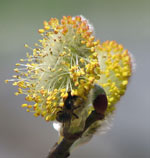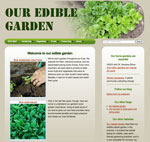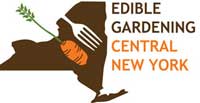Ithaca Native Landscape Symposium
March 1 & 2
|
 | | Pussy willow flower (Salix discolor) |
|
The 5th Annual Ithaca Native Landscape Symposium will be held on
March 1 & 2
The Ithaca Native Landscape Symposium is based on a simple idea: the use of native plants should remain an integral part of sustainable landscapes.
It is for landscape architects, designers, educators, Master Gardeners, government employees, homeowners,gardeners, naturalists and anyone else eager to learn more about this growing movement.
For more information and to register, visit the Ithaca Native Landscape Symposium website.
|
| Living greener together |  | |
Living Green, Living Good in CNY (www.lglgcny.org) is sponsoring the Northwest Earth Institute's discussion course A World of Health: Connecting People, Place, and Planet. (Here's more information about this course.)
We'll meet once a week for seven weeks (exact dates TBA). OCPL has purchased a set of course books that can be checked out, so participation is free for the first 8 people who register.
If you're interested
in learning more about participating, contact Janet Allen.
|
HGCNY Officers
| President:
Janet Allen
Vice-President:
Carol Biesemeyer
Treasurer:
Randi Starmer
Secretary:
Soule Leiter
Membership:
Linda Rossiter
Program Chair:
Carol Biesemeyer
Newsletter Editor:
Janet Allen
Additional Planning Committee Members:
Beth Mitchell
Dave Mitchell
Peter Huntington
John Allen
Thank you to Peter Huntington for his years of service as Secretary!
|
| Our Habitat Garden |  |
Visit Our Habitat Garden website for information on providing habitat, earth-friendly gardening practices, plants, and various creatures here in Central New York.
|
| HGCNY on Facebook |
As as more of us participate on our Facebook page, this will become a useful resource for asking (and answering!) local HGCNYers' questions about habitat gardening. |
|
Join HGCNY!
|  |
Becoming an official member of HGCNY is easy: just join Wild Ones! Basic household membership is $37/year, but there are other options, too. (See membership application or website.)
Wild Ones
P.O. Box 1274
Appleton, Wisconsin 54912-1274
Make checks payable to Wild Ones.
Or telephone toll-free 877-394-9453.
|
|
Our Edible Garden
|  | Visit OurEdibleGarden.org to see an example of a Central New York edible garden, the perfect companion to your habitat garden.
|
| Interested in Edible Gardening? | 
|
If you'd like to get information on Edible Gardening CNY, just email John to find out about edible gardening tours and monthly programs. Free and open to the public! |
|
Greetings!
 | | Green roof in early summer |
Tim Toland, Assoc. Prof. at SUNY-ESF, will discuss the exciting new projects involving native plants that are part of the ESF campus renovations. One project is an innovative green roof featuring species from two native plant communities covering a 5,000 square foot area. The projects will not only be an attractive setting for visitors but will also be learning tools for students. When: Sunday, February 24 at 2:00 pm Where: Liverpool Library ( Directions) Free and open to the publicLooking ahead
Save the dates for upcoming programs: Sun. March 24: Dan Segal of The Plantsmen Nursery in Ithaca - and a national Wild Ones Board member - will present "Cultivars of Native Plants: Thanks But No Thanks." (NOTE: NOT our usual "last Sunday of the month" schedule due to Easter.) Sun. April 28: Jim D'Angelo will return to talk about another creature in our habitat gardens. Janet Allen President, HGCNY |
|
|
Goofs in the headlines
 | |
Norway (L) vs. sugar maple
PHOTO: www.eatcology.com/invasive-vs-exotic
|
A botanist has detected that the maple leaf on the new Canadian currency is the invasive, non-native Norway maple, not a native sugar maple, the traditional symbol of Canada. You can see the maple leaf sitting there right next to Queen Elizabeth and read more about the story here.
What's wrong with Norway maples? One problem is that forests invaded by Norway maple have much less diversity in native wildflowers due in part to the dense shade cast by Norway maples and in part to their shallow roots, which compete with other vegetation. It outcompetes our beautiful native sugar maple.
GOOF #2: If you Google "monarch butterfly," you'll see in the right-hand sidebar on the results page a collection of images, supposedly of the monarch butterfly. Can you spot the Viceroy in the group?
At the bottom right, click on "Feedback," which displays each part of the collection with "Wrong?" Simply click on the Viceroy (which is the large one on the far left) to let them know it's not a monarch.
|
|
Cats and wildlife
 | | All that was left of a bird attacked by a cat |
A recent study by the Smithsonian Conservation Biology Institute and the Fish and Wildlife Service estimates that domestic cats in the US - both house pets and feral cats - kill about 2.4 billion birds and 12.3 billion mammals a year, most of them native mammals like shrews, chipmunks and voles rather than introduced pests like the Norway rat. This is 2 - 4 times higher than previous mortality estimates.
This makes the domestic cat one of the single greatest human-linked threats to wildlife in the nation. More birds and mammals die at the mouths of cats, the report said, than from automobile strikes, pesticides and poisons, collisions with skyscrapers and windmills and other so-called anthropogenic causes.
Read more from the NY Times Science article "That Cuddly Kitty is Deadlier Than You Think."
A "catio" (an enclosed outdoor space for cats and sometimes their owners, too) is one great solution! Read more and see photos of catios...
|
|
Citizen science

Join thousands of fellow citizens across the US, people from the rest of North America, and -- for the first time -- people all over the world to count birds the weekend of Friday Feb. 15 through Mon. Feb. 18. This is the 16th annual count, and probably the easiest way to participate in citizen science.
Why count birds?
Scientists and bird enthusiasts can learn a lot by knowing where the birds are. Bird populations are dynamic; they are constantly in flux. No single scientist or team of scientists could hope to document and understand the complex distribution and movements of so many species in such a short time. Scientists use the GBBC information, along with observations from other citizen-science projects, such as the Christmas Bird Count, Project FeederWatch, and eBird, to get the "big picture" about what is happening to bird populations. The longer these data are collected, the more meaningful and useful they become. ~ Read more on the GBBC website
Another way to help birds
 | | Sample data card from 1885 |
Another important project -- especially nice while winter keeps us inside -- is the Bird Phenology Project. Millions of bird information cards were created by thousands of "citizen scientists" (before the term was coined) who observed birds. But these handwritten cards aren't very useful unless they're put into a consistent digital format. That's where we come in! Honor the work of these people from the mid-1800s to the mid-1900s and help research on birds and on climate change by helping transcribe these cards. It's easy and even fun once you get in the swing of it! (I've transcribed over 5,000 cards over the last few years just while I was on the phone!) They've just created a new training manual that explains the whole process. Join in the effort and become my competitor for the most cards transcribed each week! |
|
|
|
|